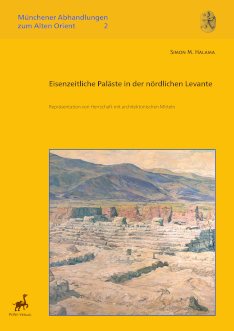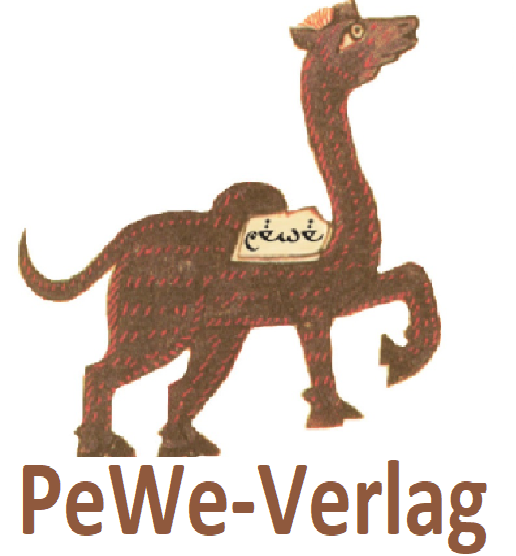
Simon M. Halama
Eisenzeitliche Paläste in der nördlichen Levante.
Repräsentation von Herrschaft mit architektonischen Mitteln.
Münchener Abhandlungen zum Alten Orient — Band 2
Format: 30 x 21 cm — Hardcover
Umfang: 384 Seiten, 90 Abbildungen im Text, 27 Abbildungstafeln und 1 Faltplan
ISBN: 978-3-935012-33-1
Preis: 58,00 €
© PeWe-Verlag 2018
Die Eisenzeit in der Levante wurde geprägt von den lokalen syro-hethitischen Staaten und den Imperien der Assyrer, Babylonier und Perser. In den syro-hethitischen Staaten wurde eine Architektur geschaffen, die mit ihrer Monumentalität und vor allem der Ausschmückung der Gebäude mit Orthostatenreliefs in Fundorten wie Zincirli Höyük, Sakçagözü, Karkamiš, Ḥamāh und Tall Taʿyīnāt beeindruckt. Die fremden Großmächte, die sich die Region unterwarfen, vor allem die Assyrer, installierten ihre Statthalter in Palästen, die sichtbares Symbol ihrer Herrschaft waren, etwa in Til Barsip, Zincirli Höyük und Tall Taʿyīnāt.
Neben vielen Studien, die sich den Bildwerken, der Stadtplanung und anderen Aspekten der Eisenzeit in der nördlichen Levante widmen, liegt nun die erste umfassende und vergleichende Monographie zu den Palästen der gesamten Periode vor. Darin untersucht der Autor sowohl die Architektur als auch die Ausstattung mit Reliefs und Wandmalereien der syro-hethitischen, assyrischen und persischen Palastbauten. Vor dem Hintergrund soziologischer Theorien zu Macht und Herrschaft analysiert er, wie Architektur und Bildwerke genutzt wurden, um zur Repräsentation und Legitimation der jeweiligen Herrscher beizutragen und rekonstruiert die zugrunde liegenden Repräsentationsstrategien. Es zeigt sich, dass sowohl lokal verwurzelte als auch fremde Herrscher sich mit ihren Palästen gegenüber der Bevölkerung und gegenüber den Eliten in unterschiedlicher Weise darstellten. Während aber die syro-hethitischen Herrscher trotz der Vielzahl an politischen Gemeinwesen ähnliche architektonische und ikonographische Konzepte teilten, überrascht die assyrische Palastarchitektur in den Provinzen mit ihrer Heterogenität, die mitunter stark von den in Assyrien etablierten Konzepten abweicht.
Durch die Kombination von Architektur- und Bildanalyse gelingen neue Einblicke sowohl in die Kulturen der syro-hethitischen Staaten als auch in die assyrische Herrschaft über die Levante.
The Iron Age in the Levant was marked, on the one hand, by the local Syro-Hittite states and, on the other hand, by the empires of the Assyrians, Babylonians and Persians. The architecture created in the Syro-Hittite states impresses strongly by its monumentality and, above all, by the sculptured orthostats decorating buildings at sites such as Zincirli Höyük, Sakçagözü, Karkamiš, Ḥamāh and Tall Taʿyīnāt. The foreign powers to whom the region became subject – especially the Assyrians – installed their governors in palaces that were visible symbols of their sovereignty, for example in Til Barsip, Zincirli Höyük and Tall Taʿyīnāt.
Besides many studies concerned with sculpture, urban planning and other aspects of the Iron Age in the northern Levant, here is now the first comprehensive and comparative monograph addressing the palaces of the period. The author examines the architecture as well as the decoration with bas-reliefs and murals of Syro-Hittite, Assyrian and Persian palaces. Against the background of sociological theories of power and sovereignty he analyses the way in which architecture and sculpture were employed in the cause of representing and legitimatising the respective ruler, and he reconstructs the underlying strategies of representation. It becomes clear that locally entrenched as well as foreign rulers differ in the manner in which they present themselves, through their palaces, towards, on the one hand, the common people and, on the other hand, the members of the elite. But while, in spite of the large number of political entities, the Syro-Hittite rulers share similar ideas about architecture and iconography, the architecture of the Assyrian palaces in the provinces surprises by its heterogeneousness, sometimes widely deviating from the concepts established in the homeland.
The combination of architectural and pictorial analysis arrives at new insights into the cultures of the Syro-Hittite states as well as into the Assyrian rule in the Levant.
